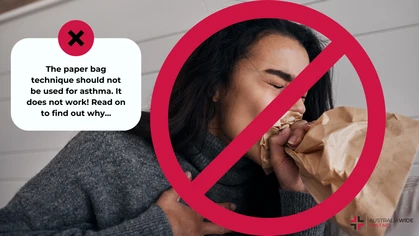Common Causes of Allergies

Allergy and Asthma

In Australia, food allergy now affects 1 in 10 infants and about 2 in 100 adults. However, food is not the only allergen affecting Australians. According to Healthdirect, about 1 in 5 people have a pet allergy, which is mostly attributed to cats and dogs.
Allergy & Anaphylaxis Australia (A&AA) is the country's peak support organisation for people living with allergy and the risk of anaphylaxis. This week, A&AA is running Food Allergy Week, a national initiative to raise awareness of, and improve the quality of life for, people affected by food allergy. Food allergy is regarded as a community issue. However, that does not mean it's the only allergy out there. Pollen, pet hair, and latex are just some of the non-food substances that can trigger allergy symptoms. We are going to be exploring these non-food allergens, and many others, to hopefully empower people to prevent, identify, and manage severe allergy symptoms.What are Allergens?
An allergen is a particular substance that can cause a person's immune system to overreact and trigger an allergic reaction. When a person experiences an allergic reaction, their immune system releases antibodies to attack and drive out the allergen. It is these antibodies, including histamines, that activate tell-tale allergy symptoms like hives, tingling in the mouth, and swelling in the face. Though some people may only ever experience mild allergy symptoms, others may have extreme sensitivities to certain allergens, which can subsequently cause anaphylaxis. Anaphylaxis is an allergic reaction on turbo mode. Instead of experiencing relatively mild symptoms like hives and swelling in the face, people experiencing anaphylaxis can experience swelling in the throat and low blood pressure, both of which can result in unconsciousness and death. More information about what anaphylaxis is can be found in our Resource Library.Latex
Latex, or natural rubber, is a substance used in many commercial products, including balloons, condoms, and a wide variety of medical equipment, such as rubber gloves and catheters. Latex is obtained from the sap of the Heavea brasiliensis tree. During the manufacturing process, it is treated with chemicals and heated in the presence of sulphur to improve its elasticity, strength, and durability. Latex is also sometimes treated with a dry powder lubricant, such as corn-starch, to prevent the rubber surfaces from sticking together. As such, people may not experience allergic reactions to the latex itself, but to the added chemicals. It is not known why latex causes allergic reactions, though it has been theorised that repeated exposure to latex can trigger allergy symptoms. This could explain why many healthcare workers have some form of latex allergy. People can experience an allergic reaction to latex by either coming into direct contact with a product containing latex, or by inhaling latex proteins that have attached themselves to corn-starch particles and been released into the air.Pet Hair
Pet hair allergies are a unique topic in that, it is not just pets that can cause allergic reactions – any animal with fur or hair can trigger allergy symptoms. This is because, it is not the fur itself that causes an allergic reaction; rather, it is the substances that stick to the fur, including dander (dead skill cells), saliva, urine, mould, and pollen, that are to blame. Dander is a particularly pervasive allergen, as it is almost microscope and does not need much air circulation to remain airborne for long periods of time. Likewise, dander can collect in upholstered furniture, on clothes, and it even occurs in dog and cat breeds described as “hairless”. This is why the Asthma and Allergy Foundation of America argues that there are no truly non-allergic dogs or cats. Dander can land on the membranes lining a person’s eyes and nose, which can cause the membranes to swell and itch, thereby resulting in a stuffy nose and inflamed eyes. It can also enter a person’s lungs and initiate respiratory symptoms like coughing, wheezing, and shortness of breath.
Hay fever, or allergic rhinitis, affects 1 in 5 people in Australia. Despite what it's name suggests, hay fever does not cause a fever, nor is it caused by hay. Rather, it is often caused by pollen, and its symptoms include a congested nose and itchy eyes.
Pollen
Pollen is a fine, powdery substance found in the flowers of trees, grasses, and weeds. Pollen is responsible for fertilising female flowers and reproducing plant species. Flowering plants, such as wattle trees, only produce small amounts of pollen. As such, they rely on birds and insects to transport their pollen from one flower to another. Other plants, including pasture grasses and weeds, rely on the wind to transport their pollen, which they produce in large quantities. Most of the pollen that causes allergies originates from grasses, trees, and weeds that are native to the northern hemisphere. This is why pollen allergies are incredibly common in Australia and New Zealand, as several types of highly allergenic weeds, including “Paterson’s Curse”, have been introduced to Australasia over the years. When a person inhales pollen, it can cause chronic inflammation of the eyes and nasal passage. This condition is known as seasonal allergic rhinitis, or hay fever, and its symptoms include irritable, watery eyes, and a runny, congested nose. Pollen can also cause asthma, especially during thunderstorms; when pollen comes into contact with water, it releases starch granules that are small enough to be breathed into the airways.Penicillin
Penicillin is a type of antibiotic drug that was first discovered by Sir Alexander Fleming, a Scottish physician and microbiologist, in 1928. Since the 1940s, penicillin has been one of the most frequently used drugs in the world to treat bacterial infections. Like other beta-lactam antibiotics, penicillin generally fights infections by attacking the walls of bacterial cells. Penicillin is widely touted as one of the most common allergens in Australia. However, studies indicate that penicillin allergies may be over-reported, and that purported allergy symptoms resulting from penicillin, such as nausea and vomiting, may actually relate to what’s called a non-immune-mediated reaction. Unlike typical immune system responses, non-immune-mediated reactions do not involve antibodies. Exanthem is another condition that’s widely misdiagnosed as a penicillin allergy. Exanthem refers to a widespread rash that is caused by an infectious condition, such as a virus. If a person suspects that they are allergic to penicillin, it is vital that they get tested by an allergist or immunologist in the first instance. If they claim to have a penicillin allergy, their attending physician may be required to use broad-spectrum antibiotics to treat the infection instead, which can lead to a longer recovery time and antimicrobial resistance.Bee Stings
When a bee stings a casualty, their barbed stinger remains lodged in the latter’s skin and can continue to release venom long after the initial sting. The bee’s venom contains proteins that affect the skin cells and immune system, and subsequently causes pain and swelling at the site of the sting, regardless of whether the casualty is allergic to the venom. When a person is allergic to the venom, however, it can cause the immune system to produce immunoglobulin E (IgE), a type of antibody. IgE typically protects the body from dangerous substances, such as viruses and parasites. As such, when the body produces IgE in response to a bee sting, it causes inappropriate and severe immune reactions like hives, swelling, and respiratory problems. Alongside wasps and ants, bees form part of a group of insects known as stinging insects. Stinging insects, in turn, are one of the most common causes of severe allergic reactions in Australia. In particular, the honeybee is the most common cause of allergic reactions to insects in Australia. Paper Wasps, likewise, are responsible for a large swathe of serious stings, as they can sting multiple times. Meanwhile, when it comes to ant stings, the Australian Jack Jumper ant is the major cause of anaphylaxis, as it is a very aggressive ant.
Originally published at
https://www.australiawidefirstaid.com.au/resources/common-causes-of-allergies
as part of the Australia Wide First Aid Articles Library









